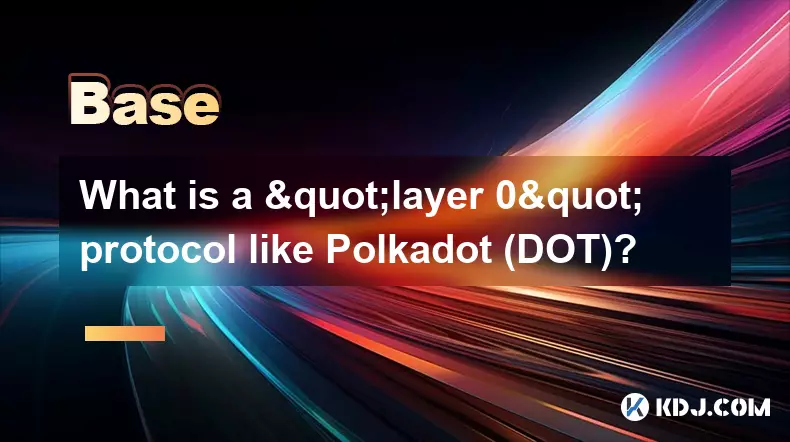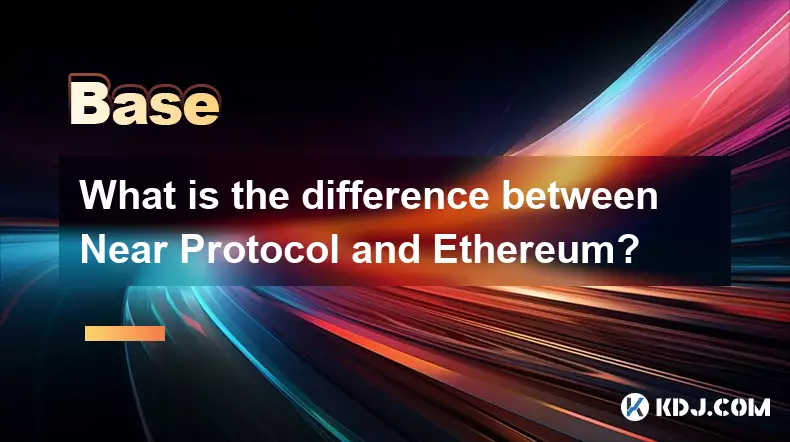-
 bitcoin
bitcoin $110323.126235 USD
1.94% -
 ethereum
ethereum $3864.833023 USD
1.25% -
 tether
tether $1.000393 USD
0.02% -
 bnb
bnb $1133.877748 USD
4.86% -
 xrp
xrp $2.393640 USD
1.11% -
 solana
solana $192.566078 USD
6.48% -
 usd-coin
usd-coin $0.999906 USD
0.00% -
 tron
tron $0.313196 USD
-2.80% -
 dogecoin
dogecoin $0.194944 USD
2.29% -
 cardano
cardano $0.643216 USD
2.65% -
 hyperliquid
hyperliquid $39.990234 USD
7.27% -
 chainlink
chainlink $17.375446 USD
0.89% -
 ethena-usde
ethena-usde $0.999536 USD
0.02% -
 stellar
stellar $0.310716 USD
0.33% -
 bitcoin-cash
bitcoin-cash $480.762464 USD
1.14%
What is a "layer 0" protocol like Polkadot (DOT)?
Polkadot’s Layer 0 enables interoperable, scalable blockchains through parachains, shared security, and cross-chain communication via XCM—revolutionizing blockchain connectivity.
Oct 16, 2025 at 12:18 pm

Understanding the Foundation: What Is Layer 0?
1. A layer 0 protocol serves as the foundational infrastructure upon which entire blockchain ecosystems are built. Unlike traditional blockchains that operate as standalone networks, layer 0 provides the base communication and data transfer protocols enabling interoperability among multiple blockchains.
2. Polkadot (DOT) is one of the most prominent examples of a layer 0 solution. It functions not as a single blockchain but as a network of interconnected blockchains known as parachains. These parachains can operate independently while still being secured and coordinated by the central Relay Chain.
3. The primary innovation of layer 0 lies in its ability to allow blockchains to communicate and exchange data or assets seamlessly. This breaks down the silos that have historically plagued the cryptocurrency space, where Bitcoin cannot natively interact with Ethereum-based tokens.
4. Layer 0 protocols handle consensus, message routing, and cross-chain validation at a foundational level. They do not process user transactions directly but enable other layers—like layer 1 blockchains—to function within a shared security and communication framework.
5. By abstracting core networking and security functions, layer 0 empowers developers to build specialized blockchains optimized for specific use cases—whether it’s DeFi, gaming, identity, or supply chain tracking—without reinventing the wheel for consensus or peer-to-peer networking.
Polkadot’s Architecture: Relay Chain and Parachains
1. At the heart of Polkadot is the Relay Chain, which coordinates the network, ensures consensus, and provides shared security across all connected parachains. It does not support smart contracts directly but exists to maintain network integrity and facilitate cross-chain messaging.
2. Parachains are independent blockchains tailored to specific applications. Each parachain connects to the Relay Chain by leasing a slot through an auction mechanism using DOT tokens. This connection grants them access to Polkadot’s security and interoperability features.
3. Collators play a vital role by maintaining parachain nodes and collecting transactions. They produce proofs that are submitted to validators on the Relay Chain, who then confirm the validity of these blocks and add them to the main consensus layer.
4. Cross-Consensus Message Format (XCM) is Polkadot’s standardized language for communication between parachains. This allows assets, instructions, and data to be transferred across different blockchains within the ecosystem without requiring centralized bridges.
5. The Nominated Proof-of-Stake (NPoS) consensus model secures the network. DOT holders can stake their tokens to nominate trustworthy validators. Validators are responsible for producing blocks and ensuring the accuracy of parachain data, creating a decentralized yet highly secure environment.
Interoperability and Scalability Advantages
1. One of the key strengths of Polkadot’s layer 0 design is native interoperability. Parachains can send messages and transfer value directly through the Relay Chain, eliminating reliance on third-party bridge solutions that are often vulnerable to exploits.
2. Scalability is achieved through parallel processing. Since each parachain processes its own transactions simultaneously, the network avoids congestion common in single-chain architectures like Ethereum during peak usage periods.
3. Upgrades and governance are community-driven. Token holders can propose changes, vote on referenda, and participate in council elections. This decentralized governance model ensures that no single entity controls the evolution of the network.
4. Specialization becomes feasible because teams can build parachains optimized for performance, privacy, or regulatory compliance. For instance, a financial institution might deploy a permissioned parachain compliant with KYC requirements while still interacting with public chains.
5. Shared security reduces the burden on individual blockchains. New projects launching as parachains inherit the security of the entire Polkadot network rather than needing to bootstrap their own validator sets, which is both costly and risky.
Frequently Asked Questions
What differentiates Polkadot from Ethereum?Polkadot is a multi-chain network designed for interoperability and scalability through parachains, whereas Ethereum operates as a single, monolithic blockchain focused on smart contract execution. Ethereum uses a global state model, making it prone to congestion, while Polkadot enables parallel transaction processing across independent chains.
How do users interact with parachains on Polkadot?Users interact with parachains via wallets compatible with the Polkadot ecosystem, such as Polkadot.js or Talisman. Once connected, they can transfer tokens, engage with dApps, or participate in parachain-specific functionalities depending on the chain’s purpose.
Can any blockchain become a parachain?Not every blockchain can become a parachain. To connect to Polkadot, a blockchain must be built using the Substrate framework or be compatible with Polkadot’s runtime and consensus mechanisms. Additionally, it must win or lease a slot in a parachain auction using DOT tokens.
What happens if a parachain fails or acts maliciously?If a parachain behaves improperly, its collators may be slashed, and its ability to submit blocks can be suspended. However, due to isolated execution environments, failures are contained within the individual parachain and do not compromise the security of the entire network.
Disclaimer:info@kdj.com
The information provided is not trading advice. kdj.com does not assume any responsibility for any investments made based on the information provided in this article. Cryptocurrencies are highly volatile and it is highly recommended that you invest with caution after thorough research!
If you believe that the content used on this website infringes your copyright, please contact us immediately (info@kdj.com) and we will delete it promptly.
- Essex Post Office, 5p Coins, and King Charles: A Royal Mint Revelation!
- 2025-10-23 10:30:16
- Waymo's Newark Airport AV Tests: Alphabet's AI Gamble Pays Off?
- 2025-10-23 10:30:16
- King Charles 5p Coins: A Royal Flush in Your Pocket?
- 2025-10-23 10:35:18
- Solana, Crypto Advisory, and Forward Industries: A New York Minute on the Future of Finance
- 2025-10-23 08:51:22
- MAGACOIN: Ethereum Whales Dive into the Hottest Presale of 2025
- 2025-10-23 08:51:22
- Kadena's End of the Road? KDA Token Plummets Amid Project Abandonment
- 2025-10-23 08:55:34
Related knowledge

How do decentralized identity (DID) solutions work?
Oct 14,2025 at 11:36pm
Understanding Decentralized Identity in the Blockchain Ecosystem1. Decentralized identity (DID) solutions are built on blockchain networks, allowing i...

What is the difference between Near Protocol and Ethereum?
Oct 15,2025 at 08:01am
Near Protocol and Ethereum: Core Architectural Differences1. Near Protocol operates on a sharded blockchain architecture known as Nightshade, which al...

What does it mean for code to be "open source" in crypto?
Oct 12,2025 at 01:54pm
Understanding Open Source in the Cryptocurrency Ecosystem1. In the context of cryptocurrency, open source refers to software whose code is publicly ac...

What is the purpose of a "testnet"?
Oct 12,2025 at 09:01am
Understanding the Role of Testnets in Blockchain Development1. A testnet serves as a parallel version of a blockchain network, designed specifically f...

How to avoid phishing scams in crypto?
Oct 13,2025 at 06:18pm
Understanding Common Crypto Phishing Tactics1. Cybercriminals frequently use fake websites that mirror legitimate crypto exchanges or wallet platforms...

What is the difference between single-collateral and multi-collateral Dai?
Oct 12,2025 at 05:18pm
Understanding Single-Collateral Dai1. Single-Collateral Dai (SCD) was the original version of the Dai stablecoin launched by MakerDAO in 2017. It allo...

How do decentralized identity (DID) solutions work?
Oct 14,2025 at 11:36pm
Understanding Decentralized Identity in the Blockchain Ecosystem1. Decentralized identity (DID) solutions are built on blockchain networks, allowing i...

What is the difference between Near Protocol and Ethereum?
Oct 15,2025 at 08:01am
Near Protocol and Ethereum: Core Architectural Differences1. Near Protocol operates on a sharded blockchain architecture known as Nightshade, which al...

What does it mean for code to be "open source" in crypto?
Oct 12,2025 at 01:54pm
Understanding Open Source in the Cryptocurrency Ecosystem1. In the context of cryptocurrency, open source refers to software whose code is publicly ac...

What is the purpose of a "testnet"?
Oct 12,2025 at 09:01am
Understanding the Role of Testnets in Blockchain Development1. A testnet serves as a parallel version of a blockchain network, designed specifically f...

How to avoid phishing scams in crypto?
Oct 13,2025 at 06:18pm
Understanding Common Crypto Phishing Tactics1. Cybercriminals frequently use fake websites that mirror legitimate crypto exchanges or wallet platforms...

What is the difference between single-collateral and multi-collateral Dai?
Oct 12,2025 at 05:18pm
Understanding Single-Collateral Dai1. Single-Collateral Dai (SCD) was the original version of the Dai stablecoin launched by MakerDAO in 2017. It allo...
See all articles










































































